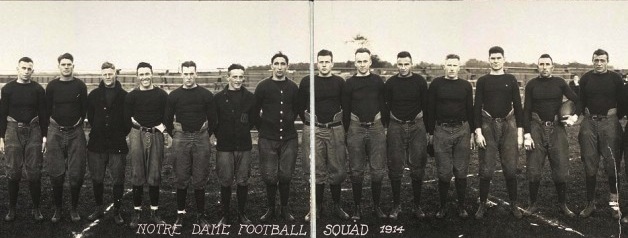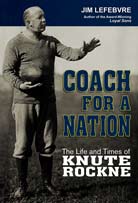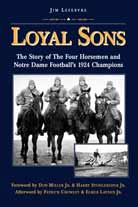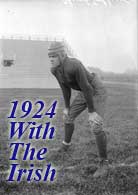Notre Dame and Syracuse first met on the gridiron to conclude the 1914 season, after the Irish had already made two trips East and lost twice, to Yale and Army. With some questioning whether the Irish really belonged in the battle against top Eastern squads, Coach Jesse Harper’s team suffocated the Orange, 20-0, and cemented its status as a true intersectional power.

The 1914 Notre Dame team traveled to Syracuse and beat The Orange 20-0 to solidify ND’s place among the football powers.
Notre Dame’s trajectory as a team that would play anyone, anywhere was set in 1913. After his hiring from Wabash College as ND’s head coach and athletic director, Harper set about creating a schedule that would take his squad to faraway places that simply didn’t appear on the schedule of other teams from the Midwest.
That first season featured the historic journey to West Point, N.Y., and a 35-13 thumping of Army, behind the passing combination of Gus Dorais to captain Knute Rockne. Just six days later, on Nov. 7, the Irish were again on a major trip, winning at Penn State, 14-7. Then, they concluded the season with a two-game journey that finished in Austin, Texas, on Thanksgiving Day, where they trounced the Texas Longhorns, 30-7, to complete a 7-0 season.
In 1914, Harper continued to seek challenging games at major venues. He scored a coup when mighty Yale—home of Walter Camp, who all but created the modern game, along with numerous national champion teams and All-Americans—agreed to meet the upstarts from South Bend. Harper and his assistant coach Rockne watched their men fall to the Elis, 28-0. And by the time they returned to campus, they had decided to change the Notre Dame attack, by introducing for the first time, what became the Notre Dame shift.
A second trip East in 1914 was a return visit to West Point, and this time the soldiers prevailed over an injury-plagued Irish outfit, 20-7. The next week, playing at Comiskey Park in Chicago, Notre Dame recovered nicely, handing the Carlisle Indians their worst loss ever, 48-6.
That left the ’14 Irish with a 5-2 record, headed to close out the season with a game at Syracuse Stadium against the powerful Orange, who had themselves played an intersectional game earlier in the season, stomping Michigan, 20-6.
Reported the Notre Dame Scholastic:
“Notre Dame, after a season of mixed success, and two unsatisfactory invasions of the East, sought…vindication of the Gold and Blue in the East. After two defeats, there were many who began to think that last year’s victory was an unusually fortunate break in luck, and that Notre Dame was not really in a class with big Eastern schools. But the whirlwind game that buried the Orange banished such thoughts for good.
“The trouncing the Orange received was much worse than the score (20-0) indicates. For nearly the whole game, Syracuse was on the defensive before the terrific onslaught of the Notre Dame offense; when driven under their goal posts, the Orange fought like tigers, and staved off scores time and again.”
As assistant coach, Rockne was guiding many of the men he had lined up with the previous three seasons. None had a greater impact than fullback Ray Eichenlaub. Every time Notre Dame needed crucial yards, Eich found his way through the Syracuse line. And on defense, the ND line could not be beaten.
Again, the Scholastic reported:
“Crowds were lined up in front of the Anderson and Welch cigar store last Thursday when the returns of the Notre Dame-Syracuse game were being megaphoned to all. After the first touchdown, boys separated themselves from their hats and shouted with gusto, and when N.D. held Syracuse on the one-yard line, the crowd went wild.
“It was Eichenlaub’s last game, the crowning glory of four years of noble service to the gold and blue. In the fourth quarter, battered and bruised and tired, Eich took off is helmet for the last time—and the applause that greeted him, echoed the thoughts of the thousands in the stands, and of Notre Dame alumni and students all over the country. Eichenlaub, equal to Salmon as the greater fullback Notre Dame has ever had; equal to any the great American game has produced – Thorpe, Brickley, Vaughan and the rest – old Eich has played his last game, and played it wonderfully well.
“This was the only sad feature of the game—that so many of her loyal sons should be striving for the honor of the gold and blue for the last time. These men, comrades on the gridiron for two, three and ever four years—members of the greatest teams Notre Dame has ever had, who carried her colors from the Atlantic to the Dakotas, from the Great Lakes to the Gulf, rarely conquered, never dispirited, and always the gentlemen, they fought for her, ten of them, for the last time, and a fight that stands as a symbol of all their former struggles.”
A Scholastic editorial opined:
“The game they played at Syracuse was a fitting close to a very successful season. We are proud of our heroes who have travelled over six thousand miles to battle on foreign gridirons. When they returned in defeat, we comforted them; now that they have finished in victory, we say, “Well done.” At the cost of extra study to make up work, at the sacrifice of their time and even the danger of physical injury, they fought for the honor of the school. For many of them, this was their last game. To the incomparable Eichenlaub, to the intrepid leader, Jones, to Finegan, Duggan, Pliska, Kelleher, Keefe, Lathrop, Elward, Mills and Bergman, we say “Good-bye.”
Referee and Chicago sportswriter Walter Eckersall observed: “Notre Dame’s decisive victory over Syracuse, 20 to 0…gives the Hoosier eleven an equal claim to the western championship with Illinois and Nebraska….The South Benders played good football against Syracuse…Notre Dame’s victory over the New York eleven, the team which decisively defeated Michigan, entitles it to recognition.”
That recognition – as a quality football outfit willing to make grueling trips by train to play top teams – would only grow in the years that followed.






